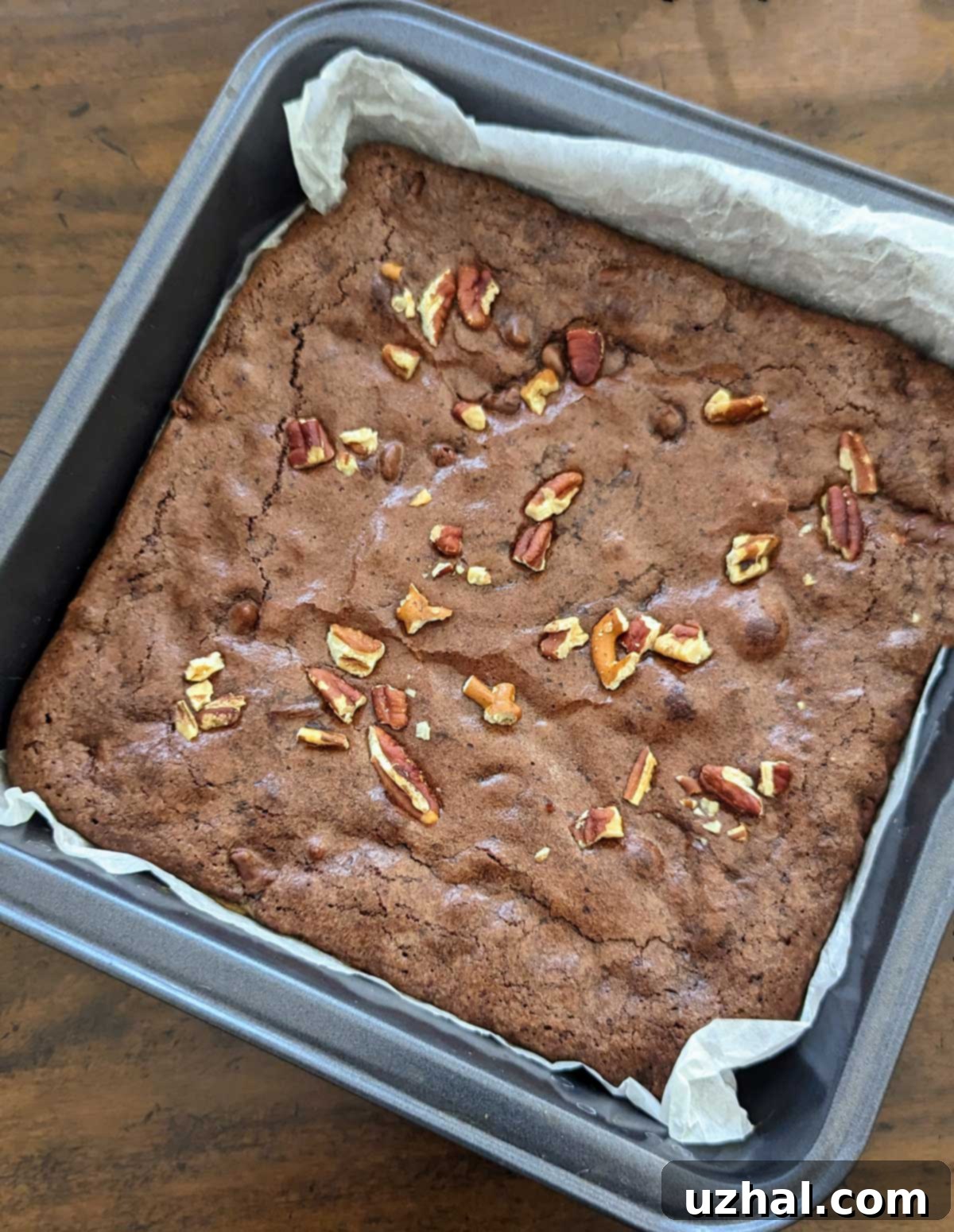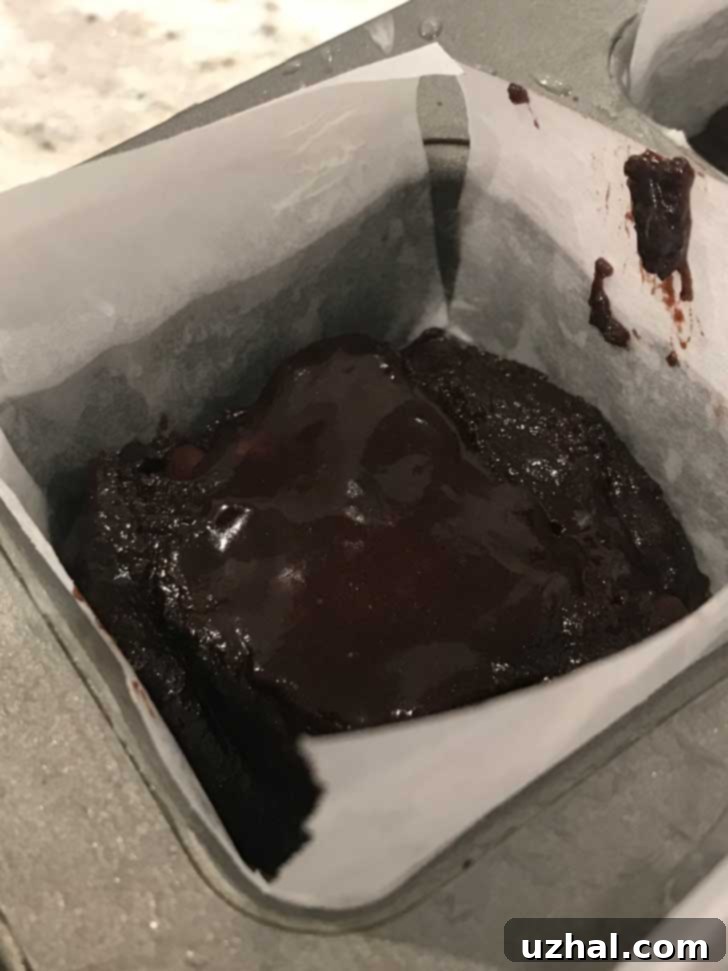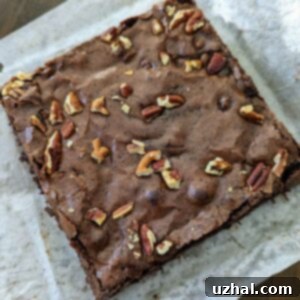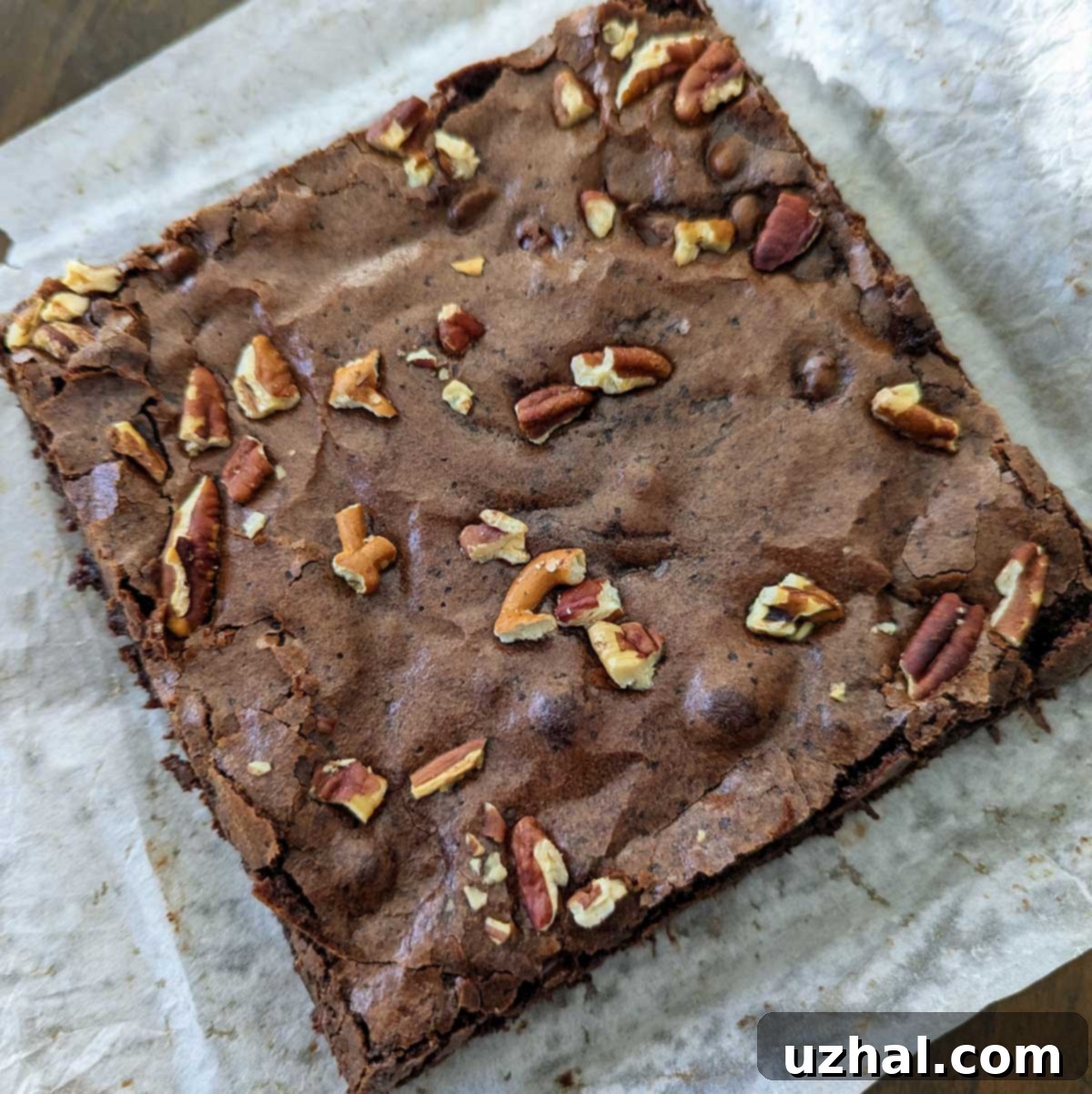The Easiest & Chewiest Homemade Brownie Recipe: Master Boxed-Style Perfection from Scratch
December 8 marks National Brownie Day, an annual celebration that gives us the perfect reason to indulge in a timeless classic: the brownie. If your ideal brownie is not merely fudgy, but boasts an irresistible chewiness that often feels exclusive to your favorite boxed mixes, then you’ve arrived at the ultimate destination. This particular recipe is renowned for delivering brownies that are incredibly easy to make from scratch, yet achieve a dense, moist, and delightfully chewy texture that many bakers chase. It’s a recipe that promises the nostalgic satisfaction of a store-bought treat with all the wholesome goodness and rich flavor of a homemade dessert. Plus, for those with dietary considerations, this versatile recipe adapts wonderfully with gluten-free flour, ensuring everyone can enjoy these chocolatey marvels!

Homemade Brownies That Taste Like Your Favorite Boxed Mix: A Culinary Achievement
For many brownie enthusiasts, the quest for the perfect chewy brownie often leads to a delightful dilemma: how to replicate the distinct texture of a beloved boxed mix at home. While scratch-made brownies are often celebrated for their rich, nuanced flavors, they can sometimes lean towards a cake-like consistency rather than the dense, fudgy chewiness craved by many. This recipe brilliantly solves that problem, offering a homemade version that perfectly captures that cherished “boxed brownie” feel.
The genius behind this recipe stems from Michelle Lopez’s highly acclaimed book, Weeknight Baking. Known for its approachable and consistently successful recipes, Weeknight Baking provides home cooks with reliable methods to create impressive desserts without fuss. This brownie recipe, in particular, has garnered significant attention, even being featured on the popular food blog Love and Lemons, where it has amassed over 6,000 glowing reviews. This widespread acclaim is a clear indicator of its ability to deliver on its promise.
The secret to its success lies in a few unconventional yet effective techniques designed to enhance chewiness. Unlike many traditional brownie recipes that rely on butter, this adaptation utilizes oil. Oil, being 100% fat, contributes to a denser, moister crumb, which is a hallmark of chewy brownies. Additionally, the inclusion of powdered sugar is another clever trick. Powdered sugar contains cornstarch, a natural thickening agent that further contributes to the dense, fudgy texture. While one could theoretically add a bit of cornstarch to regular granulated sugar, using powdered sugar simplifies the process, making it ideal for quick, weeknight baking when pantry staples are key.
Natural vs. Dutch Process Cocoa: Tailoring Your Brownie’s Flavor and Color
The type of cocoa powder you choose can significantly influence the flavor, color, and even subtle texture of your brownies. This versatile recipe accommodates both natural and Dutch process cocoa, allowing you to experiment and find your preferred profile. Understanding the distinctions will help you make an informed choice:
- Natural Cocoa Powder: This is unsweetened cocoa powder in its acidic state, typically lighter in color with a sharper, sometimes fruity, chocolate flavor. In testing, using Baker’s Corner natural cocoa powder resulted in a slightly thinner batter and a distinct yet still excellent flavor. The brownies retained their desired shine and chewiness, proving its viability for this recipe.
- Dutch Process Cocoa Powder: This cocoa has been treated with an alkali to neutralize its acidity. It’s darker, less bitter, and offers a smoother, more mellow chocolate taste. When made with Guittard Dutch process cocoa, the batter was notably thick and glistening, yielding exceptionally chewy and rich brownies with a deep, inviting color.
- The Ultimate Blend for Intense Flavor: For those who desire an even more profound chocolate experience and a truly dark brownie, combining cocoa types can be a game-changer. Our latest batch, for instance, used a blend of two parts Ghirardelli Dutch process cocoa and one part Modern Mountain Black Cocoa. This custom mixture created brownies that were remarkably similar in appearance, taste, and texture to Ghirardelli’s own Ultimate Chocolate boxed mix – a testament to how ingredient choices can elevate your homemade treats.
Beyond cocoa, the flour also plays a role in achieving that coveted chewiness. Opting for a higher protein all-purpose flour, such as King Arthur, can make a difference. The increased protein content helps develop more gluten, contributing to the structural integrity and, consequently, the desired chewy bite. And as mentioned, this recipe is incredibly adaptable, performing beautifully with a 1:1 gluten-free flour blend, making it accessible to even more brownie lovers.
The Secret to Ultimate Chewiness: Why All-Oil Brownies Stand Out
The distinctive chewiness of these brownies is largely attributable to the deliberate choice of using oil as the primary fat, rather than butter. This seemingly minor substitution has a profound impact on the final texture and moistness of the brownie. Butter contains water and milk solids, which can lead to a slightly lighter, more cake-like crumb. Oil, on the other hand, is 100% fat. This higher fat content contributes to a denser, richer, and incredibly moist brownie that resists drying out and retains its chewy character.
However, there’s a critical caveat when baking with oil: its freshness. Oil that has been exposed to air for an extended period can oxidize and develop an unpleasant, rancid, or “off” flavor. Even if the oil seems perfectly fine for savory cooking, using half a cup of compromised oil in your brownies can subtly, yet disappointingly, affect their taste. Imagine the effort of baking only to have your delicious chocolate treat marred by an undesirable undertone! Therefore, always check your oil for freshness by smelling and tasting a tiny amount before incorporating it into your recipe. A notable exception can be neutral oils like Wesson, which are often formulated to be very stable and maintain their clean flavor longer, living up to their reputation for neutrality. In a recent delightful experiment, a mixture of canola oil and buttery-flavored popcorn oil was used, which not only maintained the chewiness but also added an extra layer of rich flavor that was incredibly well-received.
Choosing a neutral-flavored oil like canola, vegetable, or even a very light olive oil (ensure it doesn’t have a strong, peppery note) is essential. The goal is to enhance the brownie’s texture and moistness without introducing competing flavors. Always prioritize freshness for the best possible outcome.
Unpacking the Irresistible Taste and Texture of the Easiest Homemade Chewy Brownies
There’s a reason these brownies have earned the title of “easiest homemade brownies” and are considered by many to be among the best for their specific category on the internet. Their simplicity in preparation does not, by any means, compromise on the rich, satisfying experience they deliver. If a profoundly chewy texture is what you seek in a brownie, then these are an absolute must-try.
The taste profile is deeply chocolatey, especially when you select a high-quality cocoa powder, making each bite a rich indulgence. But the true star here is undeniably the texture. These aren’t your airy, cake-like brownies; they are dense, incredibly moist, and wonderfully chewy, offering a substantial and satisfying mouthfeel. This distinct chewiness sets them apart from many scratch recipes and is precisely why they evoke the comforting familiarity of premium boxed brownies. They strike a perfect balance, being easy enough for even a novice baker to master, yet yielding results that taste anything but basic.
While their straightforward nature might make them less suited for a formal dinner party or an elaborate event where intricate presentation is key, they are absolutely perfect for almost every other occasion. Imagine a cozy family movie night, a casual get-together with friends, or simply satisfying a spontaneous chocolate craving – these brownies fit the bill beautifully. They are the ultimate comforting treat for those who specifically request “very chewy brownies.” Furthermore, their robust base makes them an excellent canvas for customization: sprinkle with flaky sea salt before baking for enhanced flavor, fold in chopped nuts for crunch, or swirl in a dollop of caramel or peanut butter for an extra layer of decadence. The possibilities are endless, but the core promise of an easy, chewy, and utterly delicious brownie remains constant.
The Mini Brownie Bar Pan Dilemma: A Change of Heart and a Clever Solution!
My ongoing love affair with this brownie recipe necessitates an important update regarding baking pans! Initially, I strongly advised against using mini brownie bar pans, firmly believing they would produce misshapen, unappealing “lumps of coal.” However, I am thrilled to report that I wholeheartedly retract that earlier warning. My experience has shown me a simple, brilliant trick that makes individual brownie bar pans not just usable, but highly recommended for achieving perfection.
You can absolutely use a mini brownie bar pan – or any individual cavity pan for that matter – provided you’re willing to implement one crucial step: lining each well with parchment paper. Yes, the process of meticulously cutting and fitting small pieces of parchment into each cavity might feel a bit eccentric or overly detailed at first. But I assure you, the outcome is well worth the minor effort. This method consistently yields the exact kind of chewy brownies I adore: remarkably dense, with perfectly smooth, clean sides and a uniform texture throughout. The parchment paper serves a dual purpose: it acts as a non-stick barrier for effortless removal and helps to create those pristine, defined edges that elevate the aesthetic appeal of each mini brownie. This technique truly transforms the individual baking experience, ensuring every piece is a perfect specimen of chewy chocolate goodness.
One final, yet vital, piece of advice: allow the brownies to cool completely within their individual pan inserts before attempting to remove them. Warm brownies are notoriously fragile and prone to crumbling. Patience here is paramount. Once fully cooled, they will lift out with remarkable ease, showcasing their flawlessly chewy nature and pristine, bakery-quality appearance. Embrace the parchment paper trick, and prepare to be amazed by your perfectly portioned, incredibly chewy brownies!

- Favorite Cocoa Layer Cake
- Frosted Fudge Brownies
- Homemade Peanut Butter Cups
- Jumbo Chocolate Banana Muffins
- Homemade Cookie Mix and Boxes
Recipe: The Easiest & Chewiest Homemade Brownies

Easiest Homemade Chewy Brownies
Anna
Pin Recipe
Ingredients
- 1 ½ cups granulated sugar (300 grams)
- ½ cup powdered sugar (55 grams – essential for chewiness)
- ¾ cup all-purpose flour (105 grams, ideally a higher protein brand like King Arthur, or a gluten-free 1:1 blend)
- ⅔ cup unsweetened cocoa powder (60 grams – Dutch process recommended for deep color/flavor, but natural works)
- ¾ teaspoon salt
- ½ cup dark chocolate chips (or chopped dark chocolate)
- 2 large eggs
- ½ cup neutral oil (such as canola or vegetable oil; ensure it’s extra fresh for best flavor)
- 1 teaspoon vanilla extract
- 2 tablespoons water
Instructions
-
1. Prepare Oven and Pan: Preheat your oven to 325 degrees F (160 degrees C). Line an 8-inch metal baking pan with parchment paper, allowing an overhang on two sides to create “handles.” This ensures easy lifting and removal of the cooled brownies.
-
2. Sift Dry Ingredients (if needed): If your powdered sugar, cocoa powder, and all-purpose flour appear lumpy, it’s highly recommended to sift them together. Sifting helps eliminate clumps and ensures a smoother batter and even ingredient distribution, which contributes to the consistent chewy texture.
-
3. Combine Dry Ingredients: In a large mixing bowl, whisk together the granulated sugar, sifted powdered sugar, sifted flour, sifted cocoa powder, and salt until they are thoroughly combined. Then, stir in the dark chocolate chips, ensuring they are evenly coated with the dry mixture. This simple step helps prevent the chocolate chips from sinking to the bottom during baking.
-
4. Combine Wet Ingredients: In a separate, medium-sized bowl, whisk together the large eggs, fresh neutral oil, vanilla extract, and water until they are well blended and homogenous.
-
5. Mix Wet and Dry: Pour the wet mixture into the dry mixture. Using a heavy-duty rubber scraper or a sturdy spoon, mix until just combined. Then, continue to gently beat the batter with the scraper until it becomes visibly shiny and uniform in consistency. This mixing process helps develop the desired fudgy texture, but be careful not to overmix, which can lead to tougher brownies.
-
6. Bake the Brownies: Scrape the very thick brownie batter evenly into your prepared 8-inch pan. Bake for 40 to 48 minutes at 325 degrees F (160 degrees C). The combination of a lower temperature and a slightly longer baking time is crucial for achieving that signature chewy texture without drying out the brownies. Monitor them closely towards the end of the baking time; if your oven tends to run hot, you may want to check for doneness a few minutes earlier. A toothpick inserted into the center should come out with moist crumbs, not wet batter.
-
7. Cool Completely: Allow the brownies to cool in the pan for approximately 10 minutes. After this initial cooling, use the parchment paper overhang to carefully grasp the “handles” and lift the entire slab of brownies from the pan onto a wire rack. Let them cool completely to room temperature before slicing and serving. This extended cooling period is absolutely vital for the brownies to fully set and develop their ultimate chewy texture, making them much easier to cut cleanly and preventing crumbling.
